



The Morphology of Biate, Hrangkhol, Khelma, Onaeme, Purum, Liangmai and Yimchunger
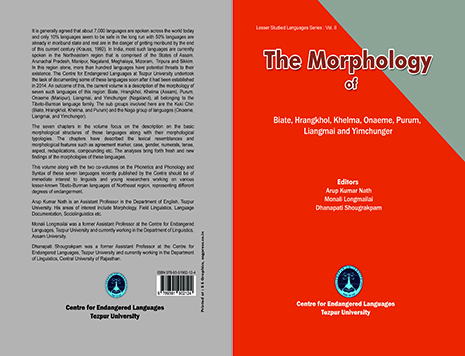
The Phonetics and Phonology of Biate, Hrangkhol, Khelma, Onaeme, Purum, Liangmai and Yimchunger
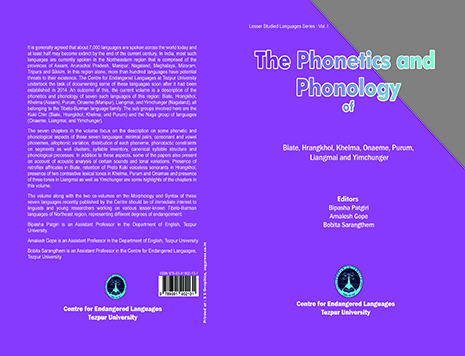
The Syntax of Biate, Hrangkhol, Khelma, Onaeme, Purum, Liangmai and Yimchunger
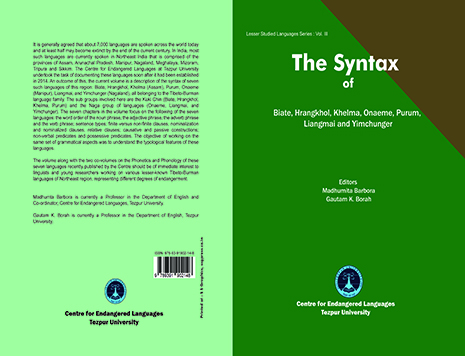
YIMCHUNGER YUTHA CHINGNÜ ANIKHITPÜ KHEHÜM (A Learner's Book of the Yimchunger Language)
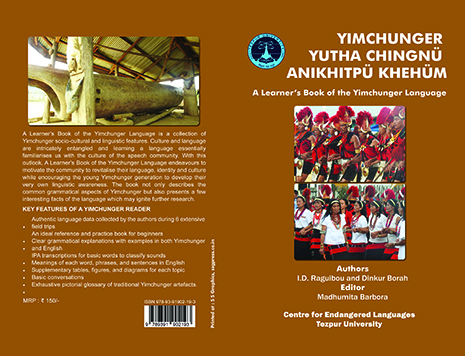
Yimchunger (ISO 639-3: yim) is one of the endangered languages of Nagaland and it belongs to the Sino-Tibetan group of the Tibeto-Burman language family. According to Burling (2003), Yimchunger belongs to the Ao group of Kuki-Naga sub-group of the Tibeto-Burman language family. It is spoken in some parts of the Tuesang and Kiphire districts of Nagaland. Bradley (1997) has classified Yimchunger under the Kuki-Chin-Naga sub-group of the Tibeto-Burman language family. According to the Ethnologue (2011) report the total number of speakers of Yimchunger is 92,100. However, according to Census Report 2001, it is 72,030. Three field trips have been conducted in the Kuthur village, which is quite a large village situated in the Sotokur sub-division of the Tuensang district, Nagaland, with a total of 422 families. It has a population of 2274 according to the 2011 Census. The literacy rate is 73.83% (2011).
Biate Ṭonga Riseina Bu (A Learner's Book Of the Biate Language)
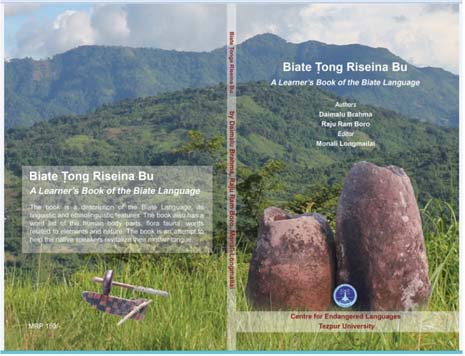
According to G. A. Grierson (1904), the Biate (BÄ’TÄ’) language belongs to the Kuki-Chin group of the Sino-Tibetan language family. UNESCO report shows that the Biate is a Definitely Endangered Language in North-Eastern India. There is very little or no information of previous research on the Biate language, though there have been literary contributions on history, origin, culture, religion and language by community members. Special mention can be made of Ramdina Lalsim, Ezra Lalsim, Remsiama Ngamlai, Rev. L. Thiate, among a handful of others. Of late, linguists have shown an interest in the comparative study of Kuki-Chin languages, including Biate, and scholars are emerging from the Biate community in documenting the language. The Centre for Endangered Languages, Tezpur University, also initiated the documentation of Biate, which led to compilation of grammatical sketch and an outline dictionary. The Centre, therefore, conducted a few pilot fieldworks in the Dima Hasao (formerly North Cachar Hills) district of Assam to complete this work.
Hrangkhol Nam Chonga Irchuna Lekhabu (A Learner's Book on the Hrangkhol Language)
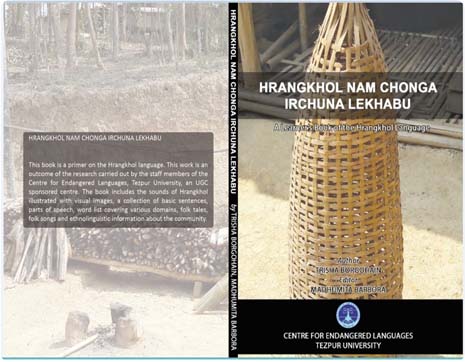
The publication of the book Hrangkhol Nam Chonga Irchuna Lekhabu is an endeavour undertaken by the Centre for Endangered Languages, Tezpur University.
This book is the result of two rigorous field works carried out in Haflong of the Dima Hasao district in Assam, India. This book includes the sound
system of Hrangkhol, basic sentences, parts of speech, folk tales, folk songs, lullabies, ethnolinguistic information about the community and a word list
covering the basic domain.
Hrangkhol is a Tibeto-Burman language, spoken in parts of Assam and Tripura. The language shares a close affinity with the Kukish languages.
The degree of mutual intelligibility between the Kuki languages, namely, Hmar, Biate, Purum, Khelma, Mizo, etc., and Hrangkhol has been observed to be rather high.
The language has been marked as ‘Vulnerable’ according to the UNESCO Endangerment Index. The total population of the Hrangkhol community has been
estimated at 18,700 according to Ethnologue sources (2000). As the language does not have a script of its own, the Roman script has been adopted in the recent
times to document the language.
Khelma Chong Anchuna Lekhabu (A Learner's book of the Khelma Language)
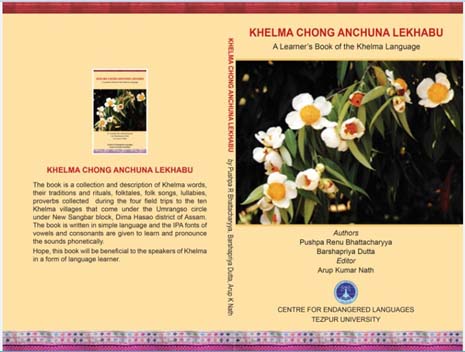
The Khelma, also known as Sakachep is a lesser-known community inhabiting in some parts of Assam, Nagaland, Mizoram and Tripura. The language of the Khelmas
is known by the same ethnic name Khelma (Sakachep), which is an unclassified language. Khelma is an undocumented language and in endangered stage. Khelma
speakers use their language at home domains only.
So far, no anthropological or linguistic research of the Khelmas has been documented. As a result, the name Khelma is not very familiar to most of the people.
It must be mentioned that except Dima Hasao, the Khelmas are known as Sakachep in other districts of Assam and neighbouring states like Mizoram,
Tripura and Nagaland.
The book is an outcome of the collected information gathered from the native speakers during four fieldtrips to ten Khelma villages that come under the
Umrangso circle under New Sangbar block, Dima Hasao district of Assam. The fieldtrips were conducted by the Research Associate and Field Assistant of CFEL,
Tezpur University.
Liangkhun Ketibu Khuang (A Learner's book of the Liangmai Language)
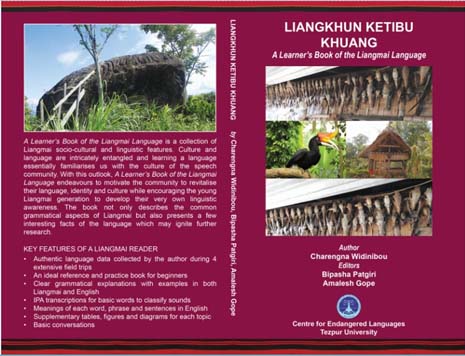
A learner’s Book of the Liangmai Language is aimed primarily at absolute beginners who want to learn how to speak Liangmai and at native speakers who have some knowledge of the language without much formal education. The book is designed as an accessible vocabulary and reference grammar of Liangmai. A Learner’s Book of the Liangmai Language is a thorough collection of the greetings, sounds, word classes, sentences, folktales, folk songs, stories, proverbs and lullabies. Additionally, it includes a range of comprehensive basic conversations which may help the learners to practice their lessons and researchers to understand the structure of the language. It also contains a pictorial glossary of indigenous terms of the Liangmai community.
Onaeme Leih Dangdo Laireiboung (A Learner's book of the Onaeme Language)
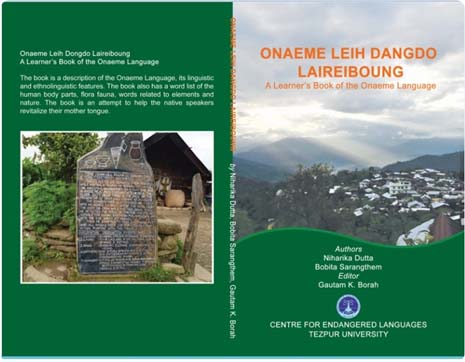
The reader is a collection of folktales, folksongs, proverbs, words, and some basic sentences of Onaeme. Onaeme is a Tibeto-Burman language, spoken by a small community of around 4000 speakers. Although the language is considered unclassified, the data and their ethnic identity show that it is rather closely related to the Poumai Naga group of the Tibeto-Burman family. This book is an attempt to preserve the richness of this endangered language mainly through documentation and archiving of the language as spoken at the present time. The book is bilingual in nature where we have used English as the medium of writing the description. The International Phonetic Alphabet (IPA) is used in Chapter 1 to show a correspondence between the Roman script used for writing the language and its sound system.
Purum Chong Kinchuna Zedetrubu (A Learner's book of the Purum Language)
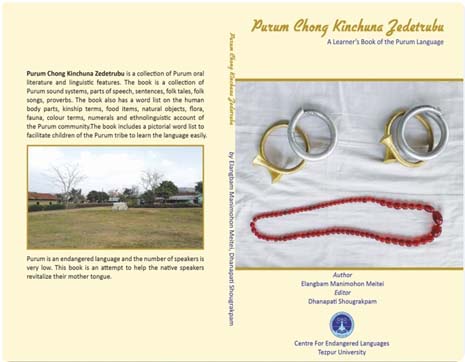
The book is a comprehensive introduction to the Purum language. It is intended to serve as a Reader or must have for any beginner in Purum.
This fruitful integration of scholarly overview and practical application provides a reader that is more than a simple grammar or an introduction to the language.
It is written in a style designed for beginners and the book avoids technical language and strives for a reader-friendly inductive approach.
The Purum Reader is a product of the research work carried out at the Centre for Endangered languages (CFEL), Tezpur University. It describes the sound system
with pictorial illustrations, parts of speech, basic conversation, sentences, folk tales, folk songs and proverbs of the community; brief overview of the
ethnolinguistic account of the community; word list of basic vocabulary; and pictorial wordlist of indigenous items of the community.